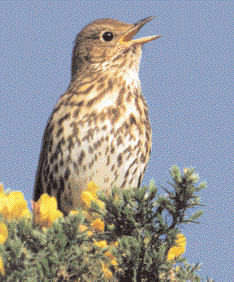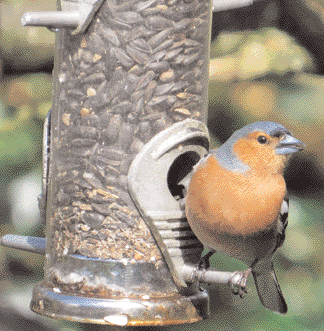|
Wildlife
Newsletter for the Township of Dalkey February 2014 - Michael Ryan |
 Song Thrush Singing |
Last
year I mentioned that in the middle of winter a branch of a Horse Chestnut
tree had produced new leaves at least five months before it should have.
Again this winter the same branch on the same tree had bright green
leaves unfolding in November but it wasn’t the only one this time.
Another horse chestnut on Killiney Hill had new leaves unfolding but
once again it was only a little crop of leaves on one single branch.
But elsewhere on the hill at least four Sycamores had new full bright
green leaves appearing a month before Christmas, some shooting from
low stumps but one tree covered in new growth on all its branches. These
freakish occurrences of plants blooming way too early and birds mating
and nest building months before they should are now reported almost
every year (a few years ago a large outdoor Christmas tree had to be
left in place way after the season had ended because a blackbird had
started to nest in it), sometimes cited as evidence of climate change
and indeed the differences between seasons does seem to be becoming
less well defined every year. The only constant that won’t change
is the length of the days and these are usually the signal that nature
responds to, telling flowers to send up new growth and birds to start
looking for partners, but when the temperature in November is often
warmer then the temperature in April you can’t blame some creatures
or plants for getting confused. |
|
In fact its usually in the new year that the weather gets hardest for
little creatures and late winter and early spring can be very difficult
for garden birds with the temperature low, frosty nights and all the
natural food, seeds and berries, gone. Birds can’t carry excess
fat and they burn up a lot of energy keeping warm at night. If you’re
lucky enough to have Long tailed tits coming to your feeders (they seem
to prefer fat balls and peanuts to sunflower seeds) you might notice
they are often the last birds to visit the feeders in the evening. They
are so small, with such a tiny body mass, they have to keep feeding
till the last opportunity before dark. There was a fascinating bit of
footage shown on TV where somebody had filmed a little group of long-tailed
tits settling down on a branch to roost on a winter night. Two of them
were perched huddled together on a branch then another bird arrived
which, instead of perching on either side of them, actually landed on
top of them and pushed its way down so it was between them. The next
birds to arrive all did the same thing pushing their way into the middle
where it was snug and warm. It might be the early bird gets the worm
but it would seem in this case the late bird gets the best seat. |
 Male Chaffinch |
|
Currently I’m refilling four or five bird feeders
every day and since there’s such a demand from hungry birds I
sometimes neglect to clean the feeders which could leave them as a potential
source of infection. If the weather is mild and wet fungus and mould
can grow on uneaten seeds or peanuts. Even if the food itself is clean,
if any birds fly in to the feeders that themselves might have a disease
that can spread to other birds. Avery nasty disease Trichomonosis (known
as Canker when it affects doves and pigeons) became very noticeable
in 2005 and caused a serious decline of some garden bird species especially
Greenfinches which were very hard hit by the disease. Affected birds
show signs of general illness (lethargy, fluffed-up plumage) and may
show difficulty in swallowing or laboured breathing. Infected birds
having difficulty swallowing food will sometimes vomit it up and if
this is eaten by other birds it can spread the infection The BTO (British Trust for Ornithology) recommends the following precautions to prevent its spread: ‘Suitable disinfectants that can be used include a weak solution of domestic bleach (5% sodium hypochlorite) or other specially-designed commercial products. Always rinse feeders thoroughly and air-dry before reuse. Rotate positions of feeders in the garden to prevent the build up of contamination in any one area of ground below the feeders. Empty and air dry any bird baths on a daily basis.’ The disease is not transmitted to humans and does not have any potential to cause harm to us so don’t be put off feeding birds when they need it most. Apart from birdseed apples ‘spiked’ on branches or threaded on a wire are a great source of energy for the birds that don’t normally come to the feeders like blackbirds and thrushes. Most songbirds don’t sing during winter, saving their song till the breeding season, but there are two very noticeable and welcome exceptions, Robins and Song Thrushes. Robins are one of the few birds to defend territory during winter and their song which often seems to have a slightly melancholy quality on short cold days but the singing Song Thrushes are a different matter. Beginning in November they pour out their song starting before sunrise and later serenading out the short days at sunset. It is reckoned that these song thrushes are young males who haven’t bred before and you’ll notice that the birds singing in winter will often have gone elsewhere by spring time. I always think the real sign that winter is over is when I hear my first blackbird singing. Last year I heard my first one singing on 6th February which was early enough but whether early or late this year I’ll be very glad to hear my first one and his beautiful mellow song. |